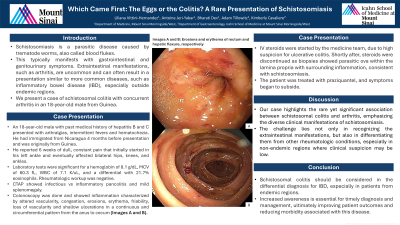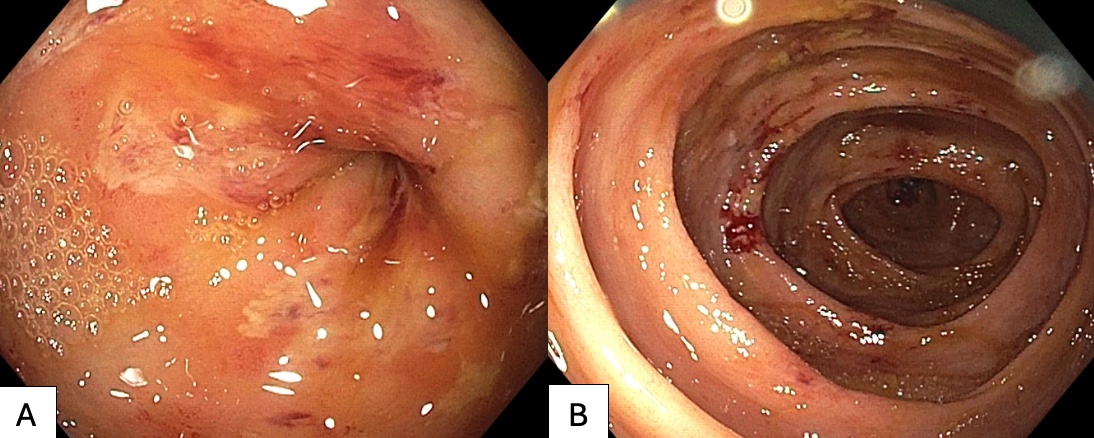Monday Poster Session
Category: Colon
P2051 - Which Came First: The Eggs or the Colitis? A Rare Presentation of Schistosomiasis
Monday, October 28, 2024
10:30 AM - 4:00 PM ET
Location: Exhibit Hall E

Has Audio

Liliana Vittini-Hernandez, MD
Icahn School of Medicine at Mount Sinai Morningside/West
New York, NY
Presenting Author(s)
Liliana Vittini-Hernandez, MD1, Antoine Jeri-Yabar, MD2, Bharati Dev, DO1, Adam Tillowitz, MD1, Kimberly Cavaliere, MD1
1Icahn School of Medicine at Mount Sinai Morningside/West, New York, NY; 2Icahn School of Medicine at Mount Sinai Morningside/West, Manhattan, NY
Introduction: Schistosomiasis is a parasitic disease caused by trematode worms, also called blood flukes. This typically manifests with gastrointestinal and genitourinary symptoms. Extraintestinal manifestations, such as arthritis, are uncommon and can often result in a presentation similar to more common diseases, such as inflammatory bowel disease (IBD), especially outside endemic regions. Here, we present a case of schistosomal colitis with concurrent arthritis in an 18-year-old male from Guinea.
Case Description/Methods: An 18-year-old male with past medical history of hepatitis B and C presented with arthralgias, intermittent fevers and hematochezia. He had immigrated from Nicaragua 4 months before presentation, and was originally from Guinea. He reported 6 weeks of dull, constant pain that initially started in his left ankle and eventually affected bilateral hips, knees, and ankles. Laboratory tests were significant for a hemoglobin of 8.1 g/dL, MCV of 60.3 fL, WBC of 7.1 K/uL, and a differential with 21.7% eosinophils. Rheumatoid factor, anti-CCP antibodies, ANA, anti-dsDNA antibodies, smith antibodies, p-ANCA, c-ANCA, RNP antibodies were negative. CTAP showed infectious vs inflammatory pancolitis and mild splenomegaly.
Colonoscopy was done and showed inflammation characterized by altered vascularity, congestion, erosions, erythema, friability, loss of vascularity and shallow ulcerations in a continuous and circumferential pattern from the anus to cecum (Images A and B). IV steroids were started by the medicine team, due to high suspicion for ulcerative colitis. Shortly after, steroids were discontinued as biopsies showed parasitic ova within the lamina propria with surrounding inflammation, consistent with schistosomiasis. The patient was treated with praziquantel, and symptoms began to subside.
Discussion: Our case highlights the rare yet significant association between schistosomal colitis and arthritis, emphasizing the diverse clinical manifestations of schistosomiasis. The challenge lies not only in recognizing the extraintestinal manifestations, but also in differentiating them from other rheumatologic conditions, especially in non-endemic regions where clinical suspicion may be low.
Furthermore, schistosomal colitis should be considered in the differential diagnosis for IBD. Increased awareness is essential for timely diagnosis and management, ultimately improving patient outcomes and reducing morbidity associated with this disease.

Disclosures:
Liliana Vittini-Hernandez, MD1, Antoine Jeri-Yabar, MD2, Bharati Dev, DO1, Adam Tillowitz, MD1, Kimberly Cavaliere, MD1. P2051 - Which Came First: The Eggs or the Colitis? A Rare Presentation of Schistosomiasis, ACG 2024 Annual Scientific Meeting Abstracts. Philadelphia, PA: American College of Gastroenterology.
1Icahn School of Medicine at Mount Sinai Morningside/West, New York, NY; 2Icahn School of Medicine at Mount Sinai Morningside/West, Manhattan, NY
Introduction: Schistosomiasis is a parasitic disease caused by trematode worms, also called blood flukes. This typically manifests with gastrointestinal and genitourinary symptoms. Extraintestinal manifestations, such as arthritis, are uncommon and can often result in a presentation similar to more common diseases, such as inflammatory bowel disease (IBD), especially outside endemic regions. Here, we present a case of schistosomal colitis with concurrent arthritis in an 18-year-old male from Guinea.
Case Description/Methods: An 18-year-old male with past medical history of hepatitis B and C presented with arthralgias, intermittent fevers and hematochezia. He had immigrated from Nicaragua 4 months before presentation, and was originally from Guinea. He reported 6 weeks of dull, constant pain that initially started in his left ankle and eventually affected bilateral hips, knees, and ankles. Laboratory tests were significant for a hemoglobin of 8.1 g/dL, MCV of 60.3 fL, WBC of 7.1 K/uL, and a differential with 21.7% eosinophils. Rheumatoid factor, anti-CCP antibodies, ANA, anti-dsDNA antibodies, smith antibodies, p-ANCA, c-ANCA, RNP antibodies were negative. CTAP showed infectious vs inflammatory pancolitis and mild splenomegaly.
Colonoscopy was done and showed inflammation characterized by altered vascularity, congestion, erosions, erythema, friability, loss of vascularity and shallow ulcerations in a continuous and circumferential pattern from the anus to cecum (Images A and B). IV steroids were started by the medicine team, due to high suspicion for ulcerative colitis. Shortly after, steroids were discontinued as biopsies showed parasitic ova within the lamina propria with surrounding inflammation, consistent with schistosomiasis. The patient was treated with praziquantel, and symptoms began to subside.
Discussion: Our case highlights the rare yet significant association between schistosomal colitis and arthritis, emphasizing the diverse clinical manifestations of schistosomiasis. The challenge lies not only in recognizing the extraintestinal manifestations, but also in differentiating them from other rheumatologic conditions, especially in non-endemic regions where clinical suspicion may be low.
Furthermore, schistosomal colitis should be considered in the differential diagnosis for IBD. Increased awareness is essential for timely diagnosis and management, ultimately improving patient outcomes and reducing morbidity associated with this disease.

Figure: Images A and B: Erosions and erythema of rectum and hepatic flexure, respectively
Disclosures:
Liliana Vittini-Hernandez indicated no relevant financial relationships.
Antoine Jeri-Yabar indicated no relevant financial relationships.
Bharati Dev indicated no relevant financial relationships.
Adam Tillowitz indicated no relevant financial relationships.
Kimberly Cavaliere indicated no relevant financial relationships.
Liliana Vittini-Hernandez, MD1, Antoine Jeri-Yabar, MD2, Bharati Dev, DO1, Adam Tillowitz, MD1, Kimberly Cavaliere, MD1. P2051 - Which Came First: The Eggs or the Colitis? A Rare Presentation of Schistosomiasis, ACG 2024 Annual Scientific Meeting Abstracts. Philadelphia, PA: American College of Gastroenterology.
